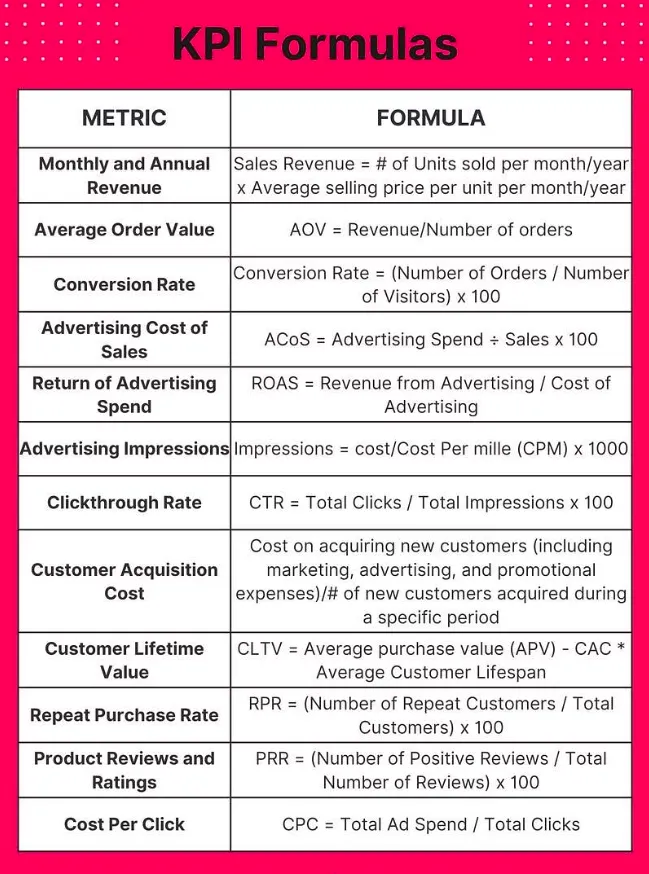What is KPI in Amazon PPC?

Amazon merchants recognize the importance of Amazon's Key Performance Indicator (KPI) data. With an array of data and analytics tools at their disposal, sellers and brands can easily access, manage, and evaluate their Amazon seller KPIs. These KPIs serve as valuable metrics for monitoring data and deriving actionable insights that support both long- and short-term goals.
Maintaining control over your KPIs is essential for those aiming to excel and achieve success—whether it's enhancing brand awareness, boosting revenue, acquiring new customers, or conducting thorough Amazon KPI analysis.
A Key Performance Indicator (KPI) serves as a metric designed to quantify business objectives and gauge progress toward those goals.
Essentially, KPIs measure the outcomes that are most crucial to your business and track your advancement toward overarching strategic aims.
Why do KPIs Matter?

KPIs Importance in PPC
KPIs offer a concise and measurable way to evaluate business success. They provide insight into whether your business is moving closer to its defined objectives, whether it's boosting brand loyalty, driving sales growth, enhancing profit margins, ensuring customer satisfaction, or achieving other vital goals. By focusing on the right KPIs, you can ensure that your efforts align with your desired outcomes.
Without KPIs—or with the wrong ones—your strategy might veer off course. Ineffective metrics could lead to misplaced efforts, where attention is paid to metrics that don't drive desired outcomes or even push your business in the wrong direction. For instance, if your aim is to acquire customers, tracking metrics like brand awareness may divert focus from essential performance areas.
How Amazon KPIs Work?
Amazon KPIs facilitate a visual comparison between a key value and its target value, typically displayed alongside a progress bar. This comparison allows sellers to gauge performance against predetermined benchmarks and track progress over time effectively.
What is Amazon Buy Box Percentage? How is Amazon Buy Box Percentage calculated?
Amazon Buy Box Percentage refers to the percentage of page views where the Buy Box appeared, enabling customers to add the product to their cart. It's a crucial metric indicating product visibility and accessibility for purchase. The Buy Box Percentage is calculated based on the frequency of Buy Box appearances compared to total page views, and it can significantly impact sales and seller competitiveness on the platform.
While sales, profit, and inventory metrics are fundamental for e-commerce businesses, they offer limited insights without a comprehensive Amazon KPI analysis. To scale effectively, sellers should delve into additional KPIs tailored to their business objectives, enabling informed decision-making and strategic planning.
How are KPIs are useful in Amazon PPC?
Key Performance Indicators (KPIs) are crucial in Amazon Pay-Per-Click (PPC) advertising for several reasons. They provide measurable values that help advertisers understand the performance of their campaigns and make informed decisions to optimize their strategies. Here’s how KPIs are useful in Amazon PPC:
1. Tracking Performance:
- Impressions: Indicates how often ads are shown. High impressions with low clicks may signal a need for better targeting or more compelling ads.
- Clicks: Shows the number of times ads are clicked. It's a direct measure of how well the ad attracts potential customers.
- Click-Through Rate (CTR): The ratio of clicks to impressions. A low CTR may suggest that ads are not relevant or appealing to the audience.
2. Cost Management:
- Cost-Per-Click (CPC): The amount spent each time someone clicks on an ad. Monitoring CPC helps in budgeting and controlling advertising costs.
- Advertising Cost of Sales (ACoS): The percentage of sales spent on advertising. It helps determine if the ad spend is generating profitable sales.
- Return on Advertising Spend (ROAS): The revenue generated for every dollar spent on advertising. It helps assess the efficiency of the ad spend.
3. Sales Analysis:
- Total Sales: The total revenue generated from PPC campaigns. It provides a direct measure of the campaign's success.
- Conversion Rate: The percentage of clicks that result in sales. A high conversion rate indicates that the landing page and product listing are effective.
4. Optimizing Campaigns:
- Search Term Report: Shows which search terms triggered ads and resulted in clicks or sales. This helps in refining keyword targeting.
- Placement Performance: Data on where ads were shown (e.g., top of search, product pages). This helps in adjusting bids for different placements.
5. Budget Allocation:
- Spend: The total amount spent on campaigns. Helps in monitoring budget utilization and reallocating funds to more effective campaigns.
6. Identifying Trends:
- Historical Performance: Comparing KPIs over time to identify trends and make data-driven decisions for future campaigns.
By regularly monitoring these KPIs, advertisers can optimize their Amazon PPC campaigns to improve visibility, increase sales, and ensure a positive return on investment (ROI).
Types of KPIs

Extensive list of KPIs Formulas
KPIs come in various types, each catering to different business needs and priorities. While there's no exhaustive list, here's an overview of 12 categories that encompass diverse KPI functions:
1. Quantitative KPIs: Measure numerical aspects like sales figures, customer lifetime value, and click-through rates.
2. Qualitative KPIs: Assess non-numerical performance, such as customer reviews and employee satisfaction.
3. Leading KPIs: Predict future outcomes based on trends, like a decrease in customer ratings signaling potential attrition.
4. Lagging KPIs: Track past performance, like product sales growth following a display ad campaign.
5. Input KPIs: Monitor resources needed to achieve results, such as budget and staff.
6. Output KPIs: Gauge outcomes resulting from inputs, like reduced customer wait times after hiring more staff.
7. Process KPIs: Evaluate the effectiveness and efficiency of business operations, such as streamlining video ad production processes.
8. Practical KPIs: Analyze how processes impact various business aspects, such as identifying wasted resources.
9. Directional KPIs: Measure trends over time, indicating positive or negative business performance shifts.
10. Actionable KPIs: Assess internal business changes, like improvements in company culture or employee satisfaction.
11. Financial KPIs: Track economic growth and stability, including revenue growth and net profit margin.
12. Outcome KPIs: Examine the impact of business actions, such as increased customer satisfaction from reduced wait times.
Examples of Marketing KPIs
In marketing, KPIs play a crucial role in assessing campaign effectiveness:
- Campaign reach: Metrics like ad impressions, email sends, and page views indicate the campaign's audience size.
- Campaign engagement: Metrics such as clicks, bounce rates, and social shares quantify audience responses.
- Campaign results: Metrics like product sales, brand recall, and conversion rates measure campaign outcomes.
Difference Between KPIs and OKRs
While KPIs track individual metrics, Objectives and Key Results (OKRs) provide a strategic framework for the business. While KPIs contribute to OKRs, the latter articulate broader organizational goals.
Creating and Defining KPIs
To create valuable KPIs:
1. Identify business goals.
2. Determine key metrics aligned with those goals.
3. Ensure measurability, establishing clear success criteria and time frames.
4. Regularly track KPI progress, using reporting tools like Amazon Attribution for marketing metrics.
By following these steps and creating a KPI dashboard for aggregated visibility, businesses can effectively measure progress toward their objectives.
Insights Drawn from Amazon KPIs:
1. Reducing Product Sales Lost due to Out-of-Stock: Utilize Amazon KPIs such as current inventory, estimated lost sales (units), unit sales per week, and sales rank to mitigate the impact of stockouts and optimize inventory management.
2. Boosting Sales: Leverage Amazon KPIs like daily sales, conversion rate, and site traffic to devise strategic plans for enhancing sales performance steadily and efficiently.
3. Increasing Buy Box Wins: Employ Amazon KPIs such as Amazon feedback rating, customer service metrics, late shipment percentage, and refund requests to enhance Buy Box eligibility and win rates consistently over time.
4. Improving Conversion Rate: Utilize Amazon KPIs like conversion rate, shopping cart abandonment rate, associated shipping rate trends, and competitive price trends to refine product listings and pricing strategies for maximizing conversion rates.
5. Enhancing Customer Satisfaction: Leverage Amazon KPIs such as the number of late shipments, total customer service inquiries, and feedback score tracking to optimize customer service processes and foster positive buyer experiences.
6. Reducing Customer Service Calls: Utilize Amazon KPIs such as service call classification, pages visited before the call, and events leading to the call to identify pain points and streamline customer service operations, ultimately reducing service call volumes.
Conclusion
These insightful pointers underscore the importance of tailoring Amazon KPI analysis to suit the unique needs and goals of individual businesses. By tracking these KPIs diligently, sellers can enhance their Amazon account health, ensuring compliance with Amazon's standards and fostering positive relationships with the platform.
While understanding Amazon KPIs and reports is crucial, sellers and vendors frequently encounter challenges such as limitations in dashboard customization, historical data availability, and the absence of a unified view across various Amazon marketplaces. In addressing these hurdles, Amzonics offer invaluable support in helping sellers reach their Amazon KPIs efficiently and effectively.
